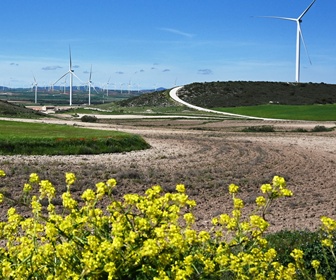Worldwide Wind Energy Boom Continues in 2005
 Wind energy has reached a status almost nobody in the conventional energy sector would have expected only ten or even five years ago: 2005 was another record year and on 31 December 2005, 58,982MW were installed worldwide, equalling an increase by 24% or 11,310MW in 2005, after 8.3GW in 2004. Thus, wind energy is the most dynamically growing energy source worldwide. Wind energy already delivers around 1% of global electricity generation, with some countries and regions reaching 20% and more.
Wind energy has reached a status almost nobody in the conventional energy sector would have expected only ten or even five years ago: 2005 was another record year and on 31 December 2005, 58,982MW were installed worldwide, equalling an increase by 24% or 11,310MW in 2005, after 8.3GW in 2004. Thus, wind energy is the most dynamically growing energy source worldwide. Wind energy already delivers around 1% of global electricity generation, with some countries and regions reaching 20% and more.By Stefan Gsänger, Secretary General, World Wind Energy Association
Wind energy today is not only increasingly recognised as a viable option to generate electricity in a sustainable and affordable way but also in several countries has become a pillar of the energy generation system. However, there is still resistance from the conventional power sector to overcome – and we still need to intensify our efforts to make affordable and clean wind power available also in the poorest world regions. While larger, grid-connected wind farms today belong to mainstream energy supply infrastructure in many parts of the world, small-scaled systems, hybrid and stand-alone systems need to benefit from that boom and will have to be given higher priority in energy policies. Also, the potentials of integrated systems comprising wind and further renewable energy, be it solar, hydro, bioenergy or geothermal, need to be tapped.
The worldwide wind sector has become a job creator and currently employs more than 235,000 people. Wind energy utilisation thus replaces expenditure on importing fossil energy resources by investment in human skills. This effect creates new income perspectives for hundreds of thousands of well-educated people.
Geographical diversification continues
It is very encouraging to see that the wind energy boom includes more and more countries and that the diversification process of the international wind energy markets continues. Europe remains in the number one position in overall capacity (40,932MW) as well as additional capacity (6,174MW). Future substantial growth can be expected in the coming years in most of the EU countries because of the increasing importance of energy security, and the European Commission announced recently that it will take care of an effective implementation of the directive for renewable energy electricity.
America now represents 10,036MW or 17% of the global wind energy capacity. Substantial growth can also be seen in Canada adding 239MW, up to 683MW. New legislation is expected in Canada later this year which will lead to major investment in manufacturing facilities, a lack of which is one of the current weaknesses of the North American markets. In Latin America first indications of an emerging wind sector can be seen, mainly in Brazil but also in Argentina where major activities in technology development have been started.
Asia is in the position to become the new global locomotive with a rate of growth of 48%, adding 2,263MW, up to an overall capacity of 7,022MW. India and China are the major drivers in Asia. Also, an increasing share of the wind turbines installed in China has been produced domestically.
Good growth can also be seen in Australia, which increased its capacity by 193MW up to 572MW. Only 11MW were added in Africa in the past year. New wind farms can be expected in the near future in Egypt as well as in Morocco, mostly based on international development funds. However, this funding has so far not led to the creation of substantial industrial capacities or activities in the African countries.
Further growth and technological diversification
A continuously dynamic growth can be expected in the coming years. Based on assessments of the WWEA members, it can be expected that 70,000MW of wind power will be installed by the end of the year 2006. In 2010, an overall capacity of 120,000MW will be in operation. In addition to the conventional grid-connected onshore and offshore wind farms, wind technologies will be applied in the mid-future on a larger scale for rural electrification in stand-alone and hybrid systems as well as for water desalination. We need to strengthen our efforts so that the whole world in its geographical, social and cultural variety can benefit from the utilisation of the friendly and emission-free energy source wind.










